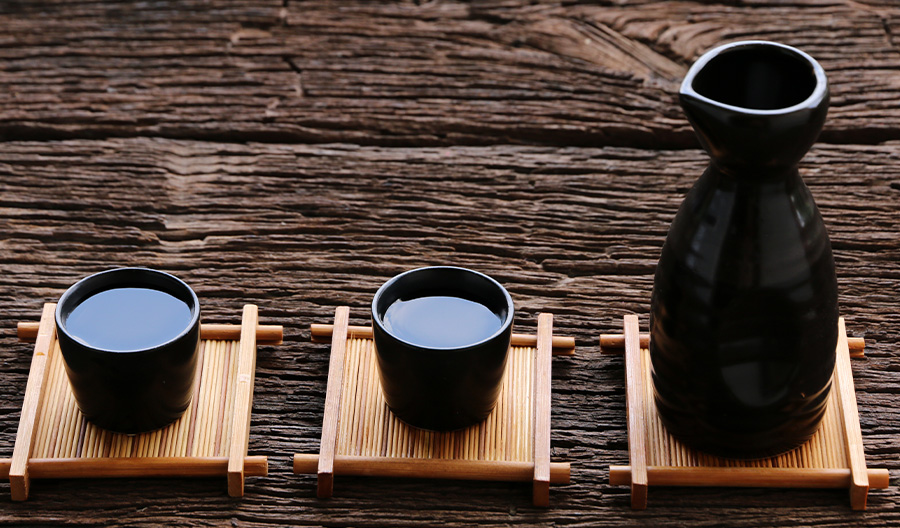Nearly all honkaku (authentic) shochu is made in Kyushu, home to more than 280 distilleries. Indeed, the highway that winds from one often-remote distillery to another is nicknamed “the shochu highway.”
This expressive spirit, which can be made from more than 50 base ingredients such as rice, barley, buckwheat, sweet potato—and more unusual ingredients like bell peppers, seaweed or pumpkin— outsells sake in its home country. Most Americans, however, are only just starting to discover it.
What Is Shochu?
A traditional Japanese distillate with roots that can be traced back to the 1500s, shochu (pronounced show-chew) can be made from more than 50 different agricultural products and is fermented using koji (a type of mold also used to make miso and soy sauce), then distilled. Many are bottled at relatively lower alcohol levels, around 25–30% abv, compared to 40% or higher for vodka and other spirits.
The result is a particularly expressive liquid that reflects the underlying ingredient and often has a faint touch of umami, thanks to the koji fermentation. Shochu made from black sugar (kokuto) from the Amami Islands can have a distinct brown sugar note, and even a funky grassiness that suggests agricole rhum; sweet potato shochu is often super-earthy; barley shochu can have a nutty, toasty character, almost like whiskey or beer; and rice shochu often is the most delicate of all, showing floral, citrus, or light tropical fruit tones.
To avoid confusion, here’s what shochu is not: It’s not “Japanese vodka,” nor is it sake (a brewed beverage made from rice) or soju (a Korean distillate).

How to Drink Shochu
In Japan, shochu is enjoyed neat or diluted with water in some way. That might mean served on the rocks, mixed with hot water to release extra aroma (oyuwari) or topped up with carbonated water into a chilled highball (mizuwari or chu-hai, a casual portmanteau of “shochu-highball”) along with other flavorings like fruit juice or green tea. During my visit, chu-hais seemed to be everywhere—from izakaya menus to canned versions at convenience stores and train station concession stands.
Though shochu may me considered seasonal, it's valued for its food-friendliness. It’s similar to wine. A bolder, barley-based shochu might pair well with roasted meats, while a lighter shochu, like a sweet potato with more floral notes, would go really well with fish or chicken. Meanwhile, the savory, toasted notes of a buckwheat shochu make a fine match for chocolate and fruit desserts, especially when topped up with hot water.
However, in the U.S., shochu is viewed as a cocktail ingredient, as bartenders build creative drinks around the spirit.
Shochu Sours & Broth-Tails
Shochu leans into my personal drinking type, which tends to be more on the low proof, low acid side of things, like highballs. It’s also a versatile ingredient, mixing easily with other spirits, citrus and liqueurs, because the flavor profiles within the category are so distinct and diverse.
While the lower alcohol levels are appealing, it can be challenging to add it to traditional cocktail structures, Momosé notes; it’s not as simple as swapping out vodka or whiskey for the same amount of shochu. Instead, it’s about finding things that draw out the flavors you find when drinking it straight.
The umami flavors can also be leaned into by mixing them into savory or smoky cocktails, such as a robust barley shochu infused with black sesame, nutmeg and orange oil.
Which Shochu Is for You?
The greatest advice for trying sochu is to remember there can be many ingredients that can make shochu. If you try a shochu and maybe don’t like the way that it tastes, remember what the base was and don’t give up yet. Try another one. If you’re a sake fan, try a rice-based shochu. If you want something darker, heartier, try sweet potato or barley.
It's helpful to use named cocktails are a reference point. For example, for those who prefer drinks with a relatively neutral vodka base, a crisp rice shochu is recommended, while gin lovers might like the floral notes of a sweet potato shochu. If someone enjoys a more robust, smokier spirit like mezcal or Scotch, a barley shochu would be recommended while if someone’s into tequila or a sweeter agave, vanilla flavor profile, the crème brûlée-like taste of black sugar shochu might go well with that. And rum lovers might take to the fruity, tropical notes of awamori, a Thai rice shochu made only in Okinawa.
Start simple. Get to know it on its own, and mix with various forms of water, whether hot water, club soda or tonic water. And if you don’t find the perfect match right away, keep looking.

